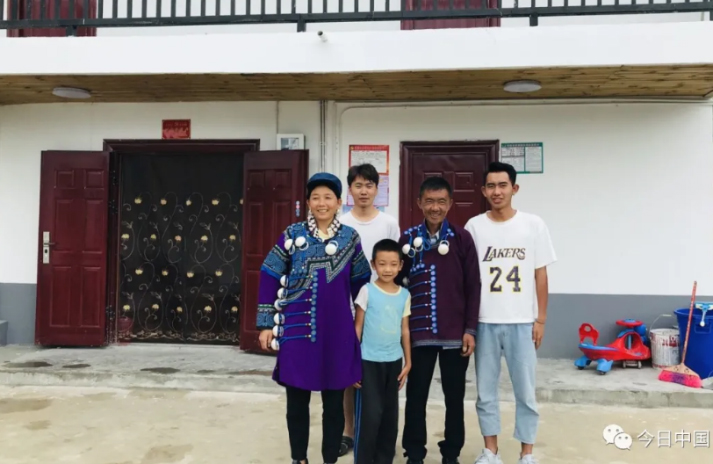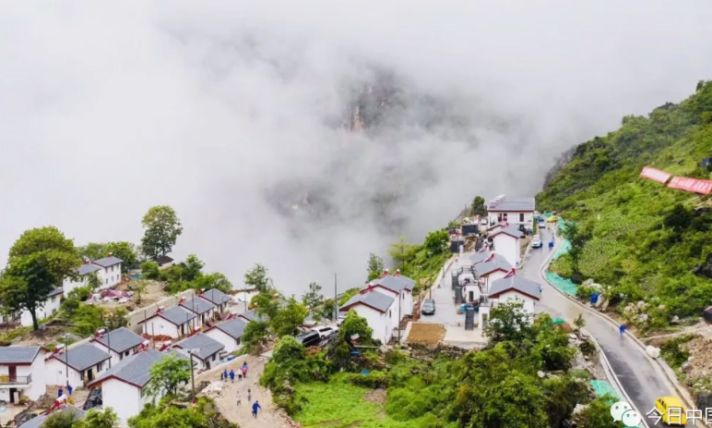| China |
| Village in southwest China makes great strides in poverty alleviation | |
|
|
 Qiesha Ci'er and his family pose for a photo in front of their new house on August 24 (MA LI)
In late August, the harvest season of walnuts, Qiesha Ci'er and his wife Jizi Mozizuo were able to sell their produce without leaving the village where they live. Abuluoha is located in Liangshan Yi Autonomous Prefecture in Sichuan Province, southwest China. A newly built road enabled merchants from other regions to travel to the village to make purchases.
Liangshan, home to a large number of Yi ethnic minority population, is a national-level poverty-stricken area. Abuluoha is surrounded by mountains on three sides and a cliff on the fourth, with only two roads for entry and exit. To access a road, the villagers had to hike for about 4 km on a cliff about 1,000 meters high, or walk down to the bottom of the valley and reach the other side of the river using ziplines. It used to be known as a leprosy village because around 300 leprosy patients were sent there for quarantine and treatment in the 1960s. Today, the disease has been eliminated thanks to improved medical treatment. Once poverty-stricken and secluded, the village has been revived and gained access to convenient transportation, water supply, and agricultural techniques. Qiesha Shigan, the eldest son of Qiesha Ci'er, left the village to work in Yantai, Shandong Province in east China, in October last year. When he returned to the village in July, he found that the village had seen great changes. "When I left for Shandong, I walked for more than four hours to cross the mountains; when I came back, a bus carried me directly to my home," Shigan told China Today. Before January 1, cable cars over valleys were installed in Abuluoha, allowing villagers to travel more conveniently. In the past, they had to carry supplies on horses. On June 26, the opening of a road ended its status as China's last village not accessible by paved road, just in time for 33 households, including 29 poor ones, to move to new two-story houses in a relocation site. The family of Qiesha Ci'er is one of them. "Without spending any money, we get an apartment of more than 80 square meters fitted with flush toilets, a TV and a washing machine. It was hard to imagine that we would move from a shabby adobe house to such a modern one," Ci'er said.
 An aerial view of the new road and newly built houses in Abuluoha Village in Liangshan Yi Autonomous Prefecture in Sichuan Province, southwest China, on August 24 (JIANG HONGJING)
Overcoming difficulties In April, Jizi Mozizuo developed hydronephrosis. "Before taking the cable car, I called the hospital in the county and asked the ambulance to wait for us at the other side of the zipline. It took my wife quickly to the hospital," Ci'er said. Before the road had opened, the villagers were especially worried when it came to taking sick people or pregnant women to the hospital for the bumpy road made them suffer. In the past, it could take over five hours to reach the hospital. "Many women gave birth halfway to the hospital," Jilie Ziri, Secretary of the Abuluoha Village Branch of the Communist Party of China, told China Today. Improvement in transportation was an urgent task. To address the transportation issue, local provincial, municipal and county-level governments decided to build a road on the cliffs. However, the construction was challenging due to the high altitude, special geological conditions and frequent collapse of loose and cracked mountain rocks caused by rainfall. Chen Ju, a constructor from Sichuan Road & Bridge Co. Ltd. still felt stressed when recalling scenes during the construction. "Landslides kept occurring as we pushed ahead with the project. For some time, we were forced to suspend construction as the excavators were smashed or fell into the deep valley," he said. In November last year, the project came to a halt due to too many difficulties. The company invited a team of senior engineers to work out solutions to key problems and draw a plan for building tunnels, bridges and subgrades. The 3.8-km road included three tunnels and a steel bridge. "This is quite rare for roads connecting villages with the outside world," Chen said. After a year of hard work, the road opened to traffic on June 26. "Building such a road cost over 10 million yuan ($1.4 million), raising concerns over whether it was worthwhile to mobilize so much labor force, resources and money to do this," Jilie said. According to him, many netizens suggested that the funds could have been used to move the whole village away from its current location. Each household could also have received subsidies during the relocation from that money. However, relocation can also have adverse effects. "It can be hard for people who have lived in this enclosed village for decades to adapt to the new environment. Most of them may fail to make a living with their limited skills. After the money distributed to them is all spent, they might return to poverty," Jilie said, suggesting that the investment may seem unworthy in the short term, but is expected to bring long-term benefits to the villagers. Sustainable development "Since poverty alleviation across China is expected to be completed by the end of this year, we are making efforts to avoid being left behind. From August 2019 to the same month this year, the per-capita income of the villagers reached 9,000 yuan ($1,317), which means Abuluoha is no longer a national-level poverty-stricken village," Jilie said. Besides the road and new houses, the improvement in villagers' income is the best news for them this year. Since last year, Jilie has led villagers to develop modern ecological agriculture. Apart from planting walnuts and Chinese prickly ash, they have also grown 3.3 hectares of navel oranges and 8 hectares of mangoes. "The mango orchards will grow to 33.3 hectares next year. It will become a major channel for improving villagers' income," he said. The village arranged targeted training for local workers to drive excavators and prune prickly ash and walnut trees. Many housewives have become skillful at pruning. To further long-term development and achieve sustainable economic growth, Jilie plans to convert more than 30 old houses near the Jinsha River into homestays and develop short-distance travel routes along the river. With the convenience brought by the road, more tourism activities including mountaineering, rock climbing, outdoor adventure and experiencing local folk customs will also be introduced. (Reporting from Liangshan Yi Autonomous Prefecture, Sichuan Province) This is an edited translation of an article originally published by China Today (Print Edition Title: A Road to Prosperity) Copyedited by Madhusudan Chaubey Comments to lixiaoyang@bjreview.com |
|
||||||||||||||||||||||||||||||
|